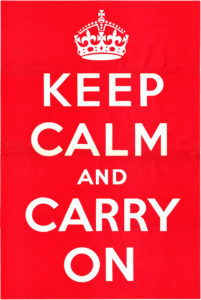
Keep Calm and Carry On was a motivational poster originally produced by the British government in preparation for World War II. The posters were intended to raise the morale of the British public who were threatened with mass air attacks. As the world faces the challenges of COVID-19, this directive and practice seems to be relevant again. What can we do individually to ‘Keep Calm and Carry On’?
Breathe
When responding to circumstances that prompt stress, our tendency is to hold our breath. Take a few deep breaths. Get up out of our seat and take a walk. Be conscious of your breathing. Oxygen is good!
Prepare
As news of grocery stores cutting hours and shelves being empty, don’t panic. Think about what you need and make plans to get it. Personally, I’ve checked food and medical supplies for at least two weeks now. Know who to call if you need help. Know how to access medical assistance, if you need it. Download or order a few books to read…the new social distancing directive may last a while.
Stay connected
As humans, we are social by nature. Now is a great time to contact loved ones, colleagues and neighbors to see how they are doing. Do this by calling, having a video conference using Zoom or Skype, or sending them a note via the mail. Plan time with your family to do things together (other than watching TV). Personally, I’ve ordered a couple of jigsaw puzzles to tackle.
Continue with as much of your routine as possible
My experience is that most of us like stability and routine. During this period of uncertainty, find a few things that you can maintain as a routine. This might include when you go to bed and wake up; dressing for work, even when you are working from home; exercising; and, keeping as many ongoing appointments as possible.
Exercise and eat well
Social distancing doesn’t mean becoming a couch potato or a hermit. Get up. Move around. Talk a walk. Use that exercise equipment in the spare bedroom or garage. Eat healthy food. Not only will it help you feel better, but it will also help you prevent getting ill.
Rest
Take time to relax. And, be sure to get your usual (or better) range of sleep.
Rethink how you spend your time at home
For some of us, working at home means spending less time commuting and more time with family. Consider that you may be “invading” the space that others have enjoyed alone. And, if you have kids home from school or college, they will be functioning in a different environment. Take their needs into consideration. Think about where you can find a space to do your work and keep it separate from others. And, now might be a good time to get some home projects completed. Schedule time to check for news updates. We live in a 24/7 news cycle, but we don’t need to be continuously bombarded with news (especially, when it doesn’t change much, and we are hearing the same stories over and over). I’ve decided to only check the news three times per day: morning, evening, and an hour before bedtime.
Stay in touch with what you can control.
A friend recently called me to talk about a challenge they are facing. Much of the challenge for them was simply understanding what was in their control, what was in their influence, and what was outside their control and influence. It is easy to take on more than we own. Once again…breathe.
What else are you are doing, or plan to do, to keep calm and carry on? As always, I’m interested in your thoughts, so please leave your comments below.
Photo by Max van den Oetelaar on Unsplash
______________
© 2020, John L. Bennett. All Rights Reserved.

